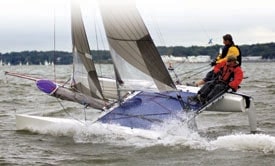
Blade F16
I vividly remember pitchpoling my buddy’s Hobie 18 on a windy day on Rhode Island’s Narragansett Bay in the early 1980s, so whenever I look at small catamarans my eyes are drawn to the bows, the root (along with poor driving skills) of many a catamaran pitchpole. Traditional bow shapes like that of the Hobie 18 rely on reserve buoyancy, i.e., the top of the hull is wider than the bottom, to keep the bows from regularly submerging. That windy day was at the forefront of my mind when we sailed the Blade Formula 16 catamaran during last year’s Boat of the Year competition. The conditions were wild and wooly, with a puffy 20-knot breeze and a nasty chop. Rather than having each of the BOTY judges sail the boat, and probably crashing and burning, we nominated Chuck Allen, our small-boat expert on the BOTY panel. We helped Allen and Blade rep Matt MacDonald rig and launch the boat in the shore break and then witnessed what judge Alan Andrews described as “watching a ball of spray scream across the horizon.” The first thing we had noticed about the Blade F16 was its reverse-sheer bows and the subtle refinements of the wave-piercing technology incorporated by the boat’s designers Phill Brander and Ian Marcovitch. The hull volume is placed low in the symmetric hulls, and as we saw during Allen’s test sail, the boat was nearly impossible to stuff, no matter how fast they were going or how awkward the seaway was. The Blade is a product of the Formula 16 box rule, which produces light, fast, gennaker-rigged 5-meter cats for single- or doublehanders. The hope was that it would be competitive against larger Formula 18 cats, but relatively easy to sail. The F16 rule dictates maximum length, beam, and sail area, as well as minimum weight. Within those parameters, designers can draw anything, as long as it measures within the box. Brander and Marcovitch have come up with a design that not only fits the box, but ushers in a new era in 16-foot catamarans. The Blade’s hulls are designed to provide lift when the boat’s flying a hull. According to its designers, and confirmed by Allen, when the Blade heels, the leeward side of the hull “stands more perpendicular to the water’s surface and the hull becomes an asymmetric, foil-type shape that creates lift to windward.” This gives the Blade its windward performance and allows the boat to remain balanced downwind with the gennaker up. “Upwind the boat wants to rise up and point higher,” says Allen, “but only when the windward hull is out of the water.” According to Allen, another benefit of the Blade’s hull form is the elimination of pitching, a common problem with some older catamaran designs. “Much like an A Class cat, there’s no hobbyhorsing,” says Allen. “It just rips through the waves. We buried the bow a few times and each time the boat popped out and continued on, where we normally would’ve pitchpoled.” The Blade’s asymmetric gennaker is flown from an aluminum bowsprit and is launched and retrieved with a single-line system. According to Allen, the aluminum wing mast’s rotation is easy to handle, even from the trapeze, thanks to the outboard-led rotator controls. In line with the ethos of simplicity, the fully battened jib is self-tacking. BOTY judge Meade Gougeon, who owns and races an A Class cat and is familiar with the pitfalls of high-performance multihulls, was likewise impressed with the Blade. “This design appeared to be unusually forgiving when the leeward bow was stuffed in a wave at speed downwind,” he says. “I wouldn’t have believed that this boat could have survived what it did if I hadn’t seen it with my own eyes.” Gougeon was also impressed with the boat’s rig. “For a 16-foot cat, this boat has a huge rig, a 30-foot mast that one would expect to see on much larger cats, such as a Tornado,” says Gougeon. “Its mast-height-to-waterline-length ratio (32 to 16) is 200 percent, which sets a record in my book. Twenty years ago such a ratio would’ve been considered impractical for heavy air, but we saw how well the thing worked in big air and waves.” The Formula 16 box rule allows for boats to be built of any material. The original intent by the Blade’s designers was that it be a kit boat, but the Blade Allen sailed was a pre-production version of vinylester and fiberglass skins and foam core, built by Vectorworks Marine Sail in Titusville, Fla. While Formula 16 class racing is established in Europe, it’s still in its infancy in the United States. MacDonald says he’s starting to see a trickle of F-16 activity, mainly in Florida. The boat currently has a Portsmouth Rating of 65.3, which puts it in the realm of the A Class cat (64.8) and the Taipan 4.7 (65.3). The Blade F16 can be built with Kevlar for an extra $500, and the sails can be upgraded to Pentax for an additional $300. Carbon daggerboards, kick-up rudders, and stocks are also options. The boats are sold as complete, ready-to-sail packages and a trailer is available from Vectorworks for $900. Blade F16 LOA: 16’4″ Beam: 8’2″ Weight: 240 lbs. SA: (u/d) 210 sq. ft./398 sq. ft. Designers: Phill Brander and Ian Marcovitch Price: $12,900 www.vectorworkssail.com









